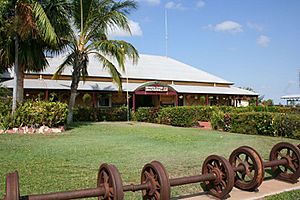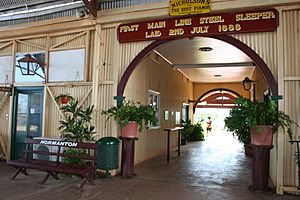Normanton railway station, Queensland facts for kids
Quick facts for kids Normanton railway station |
|
|---|---|

Normanton railway station, 2010
|
|
| Location | Matilda Street, Normanton, Shire of Carpentaria, Queensland, Australia |
| Design period | 1870s - 1890s (late 19th century) |
| Built | 1889 |
| Official name: Normanton Railway Terminus | |
| Type | state heritage (landscape, built) |
| Designated | 21 October 1992 |
| Reference no. | 600395 |
| Significant period | 1889-1960s (historical) |
| Significant components | platform, views to, shed/s, views from, shed - goods, crane / gantry, tank - water, carriage shade (railway), railway station, machinery/plant/equipment - transport - rail |
| Lua error in Module:Location_map at line 420: attempt to index field 'wikibase' (a nil value). | |
The Normanton railway station is a historic train station located on Matilda Street in Normanton, Australia. It was built in 1889 and is a very important part of Queensland's history. This station is listed on the Queensland Heritage Register, meaning it's protected for its special value. Today, it's a popular tourist spot and serves as a station for the famous Gulflander train line.
Contents
The Story of Normanton Railway Station
Why Was the Railway Built?
The railway complex at Normanton was built to connect the port town of Normanton with the goldfields at Croydon. People first talked about building a railway line between Normanton and Cloncurry in 1883. This area was hard to travel through, and a train link would help local farms and the Cloncurry Copper Mine.
However, in 1885, a big discovery of gold happened near Normanton. By 1886, thousands of people had moved to the Croydon goldfield. Getting supplies and people to Croydon became more important than the link to Cloncurry. So, the plan changed, and the railway was redirected to Croydon.
Building the Unique Railway Line
Construction of the railway began in May 1888. The project was led by George Phillips, who was also a surveyor. He had explored the Normanton area years before. The land around Normanton was challenging for building a railway. It often flooded, and there wasn't much good timber for traditional tracks. Termites were also a big problem, as they would eat wooden sleepers.
In 1884, George Phillips came up with a special design for railway tracks. He used U-shaped steel sleepers that lay directly on the ground. This design meant the tracks could be underwater during floods without being washed away. Once the water went down, the trains could run again quickly. The steel sleepers also couldn't be damaged by termites. Even though they cost more at first, they were cheaper to lay and maintain. This special system was used for the Normanton to Croydon line. The railway reached Croydon in July 1891.
What the Station Looked Like
The station building and its large carriage shade were designed around 1889 by James Gartside, working under George Phillips' guidance. When it was new, the Normanton station was a busy place. It had offices for the station master and traffic manager, a waiting room, and a booking office.
A huge, curved roof called a "carriage shade" was attached to the station building. It covered the platform and three train tracks, protecting passengers and trains from the sun and rain. The station also had a large goods shed with a crane for loading and unloading items. Because the railway was far from other lines, it also had workshops for maintaining trains, including a fitting shop and a blacksmith's shop.
The Railway's Later Years
The gold rush at Croydon didn't last forever. By the early 1900s, gold production dropped a lot. After World War I, mining decreased even more. Train traffic on the line was never very high and slowly went down. However, the railway remained open because it was important for the community. It was also a vital link during the wet season. George Phillips' special track system worked well, allowing the line to reopen quickly after floods, while roads stayed impassable for much longer.
In the 1920s, the railway started using "railmotors" instead of steam locomotives. Railmotors were more efficient and didn't need as much water, which was hard to find along the line. The first railmotor, a Panhard, was used in 1922. By 1929, only railmotors were used. In the 1980s, diesel locomotives were added.
Over time, some of the workshop buildings at the station were removed as they were no longer needed. Today, the Normanton railway station mainly serves as a tourist attraction. One of the railmotors was restored in 1978 and named the "Gulflander".
What Normanton Station Looks Like Today
The Normanton railway station buildings stand out against the flat landscape at the edge of town. The main buildings you can see today are the station building with its attached carriage shade, the goods shed, a water tank, and a vertical boiler.
The Station Building
The station building is shaped like a rectangle. It has offices on both sides of a central arched hallway. It's built from corrugated iron and timber, sitting on a flat concrete slab. The timber frame of the walls is visible on the outside, which adds a decorative touch. The windows are made of timber and have sashes that slide up and down. Inside, the walls are lined with corrugated iron. The roof is also made of corrugated iron and has a hipped shape (sloping on all four sides).
A verandah (a covered porch) with a curved corrugated iron roof runs along the sides and the front of the building. A small gable (a triangular part of the roof) marks the main entrance on the street side. Today, the rooms in the station building are used as a museum, a shop, a tea room, and an office for the officer in charge. The ceilings are made of timber and still have their original paint colors. Some of the old furniture is still there.
The Carriage Shade
From the platform side of the station building, a huge steel-framed carriage shade stretches out. It's supported by decorative cast iron columns made by the Toowoomba Foundry. This shade covers three train tracks and has a continuous vent along its top ridge to let out hot air. The curved roof has a decorative scalloped metal edge at each end.
The Goods Shed and Other Features
The goods shed is located across the tracks from the station building. It's also made of corrugated iron but has a simpler design. Even so, its simple lines and arched entrances match the more detailed station building. Inside, it has a platform for loading goods. Outside, there's a large 5-ton crane from around 1902, used for heavy lifting.
Near where the engine shed used to be, you can find the water tank. It's a single-level tank on a cast iron stand. You can also still see the foundations and walls of the old workshops, as well as an old vertical boiler. Scattered around the yards are parts of old locomotives, tenders, and sections of the unique railway line and sleepers.
Why Normanton Railway Station is Important
Normanton railway station was added to the Queensland Heritage Register in 1992 for several reasons:
- It shows how Queensland grew: The railway station and line show how railways helped connect ports with important inland resources, like goldfields. It was built on a large scale, showing how important and prosperous the area was expected to be.
- It's a unique part of history: It's a very well-preserved and special terminal station for a railway line that was isolated from others. It still has its carriage shade attached to the station building, covering the platform and tracks, and a goods shed with its original crane.
- It's a great example of railway design: The Normanton railway station is a beautiful and interesting example of railway architecture from the late 1800s. Its size, shape, and clever use of local materials make it a striking and important building in Normanton.
- It shows amazing technical skill: The railway itself, with its low-level tracks that could be submerged and George Phillips' special steel sleepers, was a very important and long-lasting technical invention. The station buildings, also designed under Phillips, show a creative and practical use of materials for this challenging location.
- It's linked to important people: The station is strongly connected to George Phillips, who helped explore and survey the area. He also served as a local politician and designed and oversaw the building of the railway. It's also linked to James Gartside, who drew the designs for the station buildings.
Images for kids




